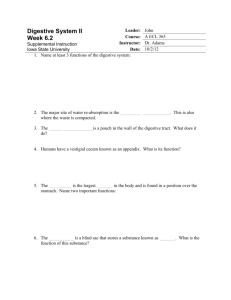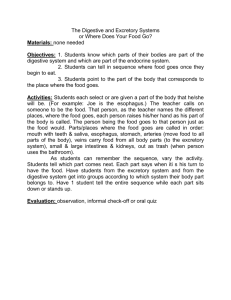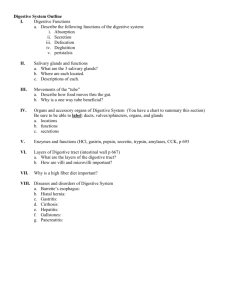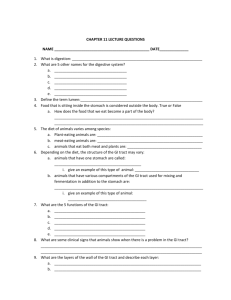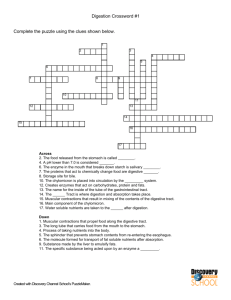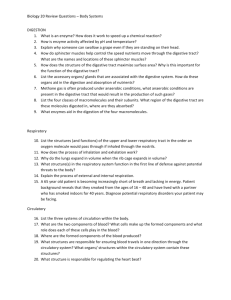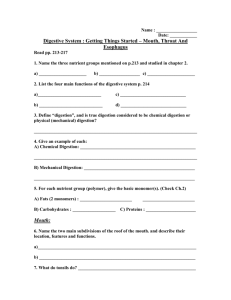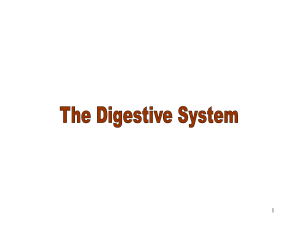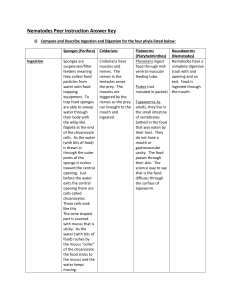The Digestive Tract 14 - Westgate Mennonite Collegiate
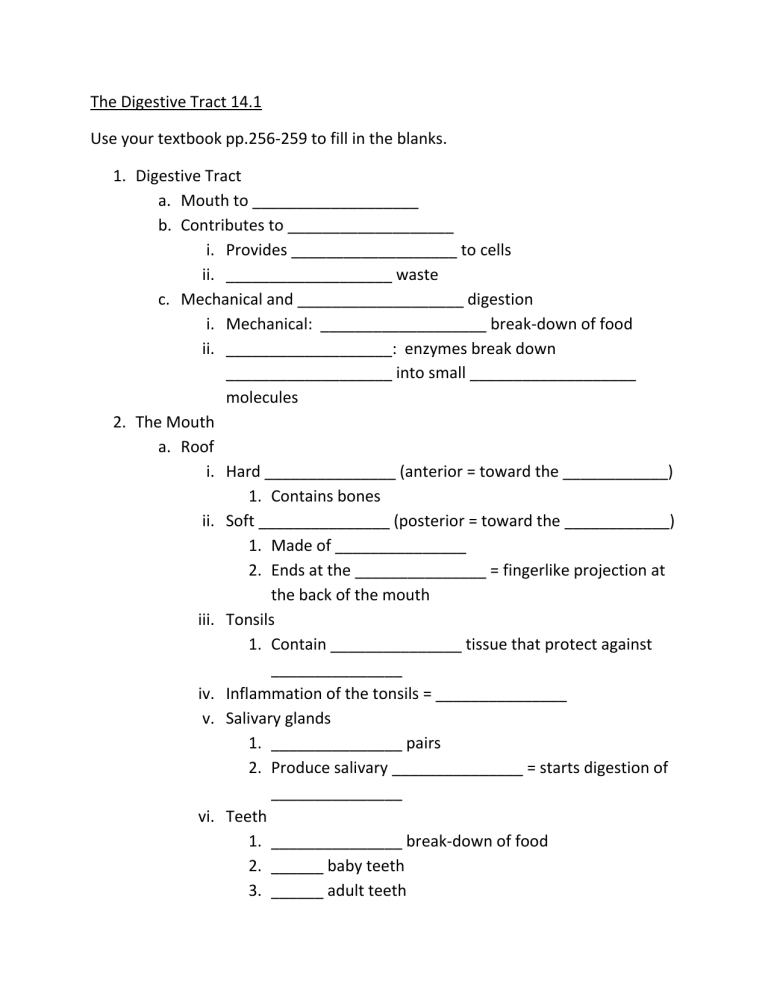
The Digestive Tract 14.1
Use your textbook pp.256-259 to fill in the blanks.
1.
Digestive Tract a.
Mouth to ___________________ b.
Contributes to ___________________ i.
Provides ___________________ to cells ii.
___________________ waste c.
Mechanical and ___________________ digestion i.
Mechanical: ___________________ break-down of food ii.
___________________: enzymes break down
___________________ into small ___________________ molecules
2.
The Mouth a.
Roof i.
Hard _______________ (anterior = toward the ____________)
1.
Contains bones ii.
Soft _______________ (posterior = toward the ____________)
1.
Made of _______________
2.
Ends at the _______________ = fingerlike projection at the back of the mouth iii.
Tonsils
1.
Contain _______________ tissue that protect against
_______________ iv.
Inflammation of the tonsils = _______________ v.
Salivary glands
1.
_______________ pairs
2.
Produce salivary _______________ = starts digestion of
_______________ vi.
Teeth
1.
_______________ break-down of food
2.
______ baby teeth
3.
______ adult teeth
4.
Dental _______________ = cavities a.
Caused when _______________ stuck on teeth
_______________ sugars and produce
_______________ which erode tooth
_______________ (the hard protective coating) b.
Prevention: i.
Brushing, flossing ii.
_______________ in water/treatments strengthen enamel iii.
Avoid acidic drinks (citrus juices and pop, for e.g.) and sugary foods c.
Tooth whitening treatments i.
Enamel _______________ from cigarette smoke, coffee, soft drinks, etch. ii.
_______________ treatments can be used to remove stains.
3.
The Pharynx a.
The region that receives air from the _______________ cavity and food from the mouth (called a “bolus”) b.
Swallowing i.
Occurs here ii.
A _______________ action (no conscious effort required)
1.
Soft _______________ moves back and closes
_______________
2.
_______________moves up under the epiglottis to cover the _______________ (Glottis is the opening to the _______________ or voice box, which is also the opening to the air passageway.)
3.
Observable through up-down movement of
_______________’s apple (front part of larynx)
4.
Breathing _______________ during swallowing
4.
The Esophagus a.
Long _______________tube
b.
Starts at _______________, passes through the _______________ cavity and _______________, into the abdominal _______________ and ends at the _______________ c.
_______________ pushes food through i.
Rhythmic c_______________ along the digestive tract d.
Sphincters i.
Muscles that _______________ tubes ii.
Act as _______________ iii.
Cardiac sphincter controls opening b/t _______________ and esophagus
1.
Failure to keep acid in the _______________ and out of the esophagus results in heartburn iv.
Pyloric _______________ controls opening b/t stomach and small _______________
5.
The Walls of the Digestive Tract: 4 layers a.
_______________ i.
Inner layer ii.
Layer of _______________ (skin cells) iii.
Secretes digestive _______________ and mucous b.
Submucosa i.
Beneath _______________ ii.
Broad _______________ of connective tissue iii.
Contains blood _______________ iv.
Contains lymph _______________ (provide disease protection) c.
Muscularis i.
Smooth _______________ layer ii.
Two layers
1.
inner layer: _______________
2.
_______________ layer: longitudinal d.
Serosa i.
Outer _______________ ii.
Thin epithelium (skin cells)
iii.
_______________ fluid to keep outer surface
_______________ (aids in organs sliding over each other instead of sticking to each other
Make sure you’ve answered p. 257 #1-2 and p.259 #1-3
Read pp.260-262 and answer p.261 #1-2 and p.262 #1-2
The Digestive Tract 14.1
1.
Digestive Tract a.
Mouth to anus b.
Contributes to homeostasis i.
Provides nutrients to cells ii.
Eliminates waste c.
Mechanical and chemical digestion i.
Mechanical: physical break-down of food ii.
Chemical: enzymes break down macromolecules into small organic molecules
2.
The Mouth a.
Roof i.
Hard palate (anterior = toward the front)
1.
Contains bones ii.
Soft palate (posterior = toward the back)
1.
Made of muscle
2.
Ends at the uvula = fingerlike projection at the back of the mouth iii.
Tonsils
1.
Contain lymphoid tissue that protect against infection
2.
Inflammation of the tonsils = tonsillitis iv.
Salivary glands
1.
Three pairs
2.
Produce salivary amylase = starts digestion of starches v.
Teeth
1.
Mechanical break-down of food
2.
20 baby teeth
3.
32 adult teeth
4.
Dental caries = cavities a.
Caused when bacteria stuck on teeth metabolize sugars and produce acid which erode tooth enamel (the hard protective coating)
b.
Prevention: i.
Brushing, flossing ii.
Fluoride in water/treatments strengthen enamel iii.
Avoid acidic drinks (citrus juices and pop, for e.g.) and sugary foods c.
Tooth whitening treatments i.
Enamel stains from cigarette smoke, coffee, soft drinks, etch. ii.
Bleaching treatments can be used to remove stains.
3.
The Pharynx a.
The region that receives air from the nasal cavity and food from the mouth b.
Swallowing i.
Occurs here ii.
A reflex action (no conscious effort required)
1.
Soft palate moves back and closes nasopharynx
2.
Trachea moves up under the epiglottis to cover the glottis (Glottis is the opening to the larynx or voice box, which is also the opening to the air passageway.)
3.
Observable through up-down movement of Adam’s apple (front part of larynx)
4.
Breathing stops during swallowing
4.
The Esophagus a.
Long muscular tube b.
Starts at pharynx, passes through the thoracic cavity and diaphragm, into the abdominal cavity and ends at the stomach c.
Peristalsis pushes food through i.
Rhythmic contractions along the digestive tract d.
Sphincters i.
Muscles that encircle tubes ii.
Act as valves
iii.
Cardiac sphincter controls opening b/t stomach and esophagus
1.
Failure to keep acid in the stomach and out of the esophagus results in heartburn iv.
Pyloric sphincter controls opening b/t stomach and small intestine
5.
The Walls of the Digestive Tract: 4 layers a.
Mucosa i.
Inner layer ii.
Layer of epithelium (skin cells) iii.
Secretes digestive enzymes and mucous b.
Submucosa i.
Beneath mucosa ii.
Broad band of connective tissue iii.
Contains blood vessels iv.
Contains lymph nodules (provide disease protection) c.
Muscularis i.
Smooth muscle layer ii.
Two layers
1.
inner layer: circular
2.
outer layer: longitudinal d.
Serosa i.
Outer layer ii.
Thin epithelium (skin cells) iii.
Secretes fluid to keep outer surface moist (aids in organs sliding over each other instead of sticking to each other
Make sure you’ve answered p. 257 #1-2 and p.259 #1-3
Read pp.260-262 and answer p.261 #1-2 and p.262 #1-2
